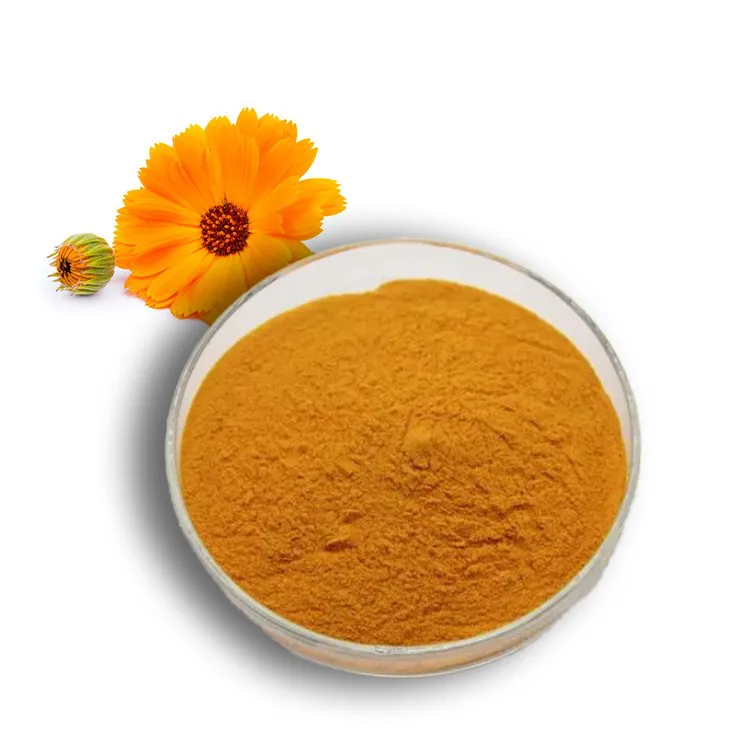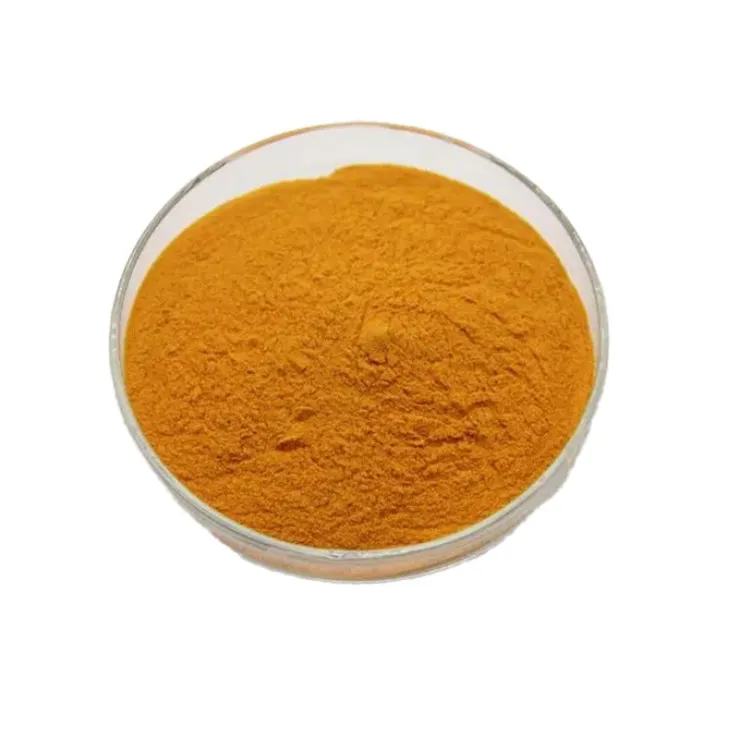- 0086-571-85302990
- sales@greenskybio.com
Calendula Extract: From Leaves to Extraction.
2024-11-12

1. Introduction to Calendula
Calendula, a plant renowned for its various properties, has been utilized for centuries. It is often recognized for its bright yellow or orange flowers, but the leaves of calendula also play a crucial role in the extraction process that yields valuable products. Calendula is native to the Mediterranean region, but it is now cultivated in many parts of the world due to its growing popularity in different industries.

2. Selecting High - Quality Calendula Leaves
The first step in the extraction of Calendula Extract from the leaves is the careful selection of the leaves themselves. This is a vital process as it determines the quality of the final extract.
2.1. Growing Conditions
Calendula leaves grown in optimal conditions are more likely to be rich in bioactive compounds. These plants prefer well - drained soil,充足的阳光 (adequate sunlight), and a moderate climate. Leaves from plants grown in poor soil or under stress may have lower levels of the desired substances.
2.2. Harvesting Time
The time of harvesting also significantly impacts the quality of the leaves. Generally, the leaves should be harvested at the appropriate stage of growth. Harvesting too early may result in leaves that have not fully developed their bioactive compounds, while harvesting too late may lead to a decline in the quality of these compounds due to factors such as natural degradation or pest damage.
2.3. Inspection for Purity
Once harvested, the calendula leaves need to be inspected for purity. This involves removing any foreign matter such as dirt, other plant parts that are not the calendula leaves, or signs of pest infestation. Only pure, high - quality leaves should be selected for the extraction process.

3. Bioactive Compounds in Calendula Leaves
Calendula leaves are rich in a variety of bioactive compounds, which are the main reason for the value of the extract.
3.1. Flavonoids
Flavonoids are one of the major groups of bioactive compounds found in calendula leaves. They are known for their antioxidant properties, which help in protecting cells from damage caused by free radicals. Examples of flavonoids in calendula include Quercetin and kaempferol. These compounds play a role in reducing inflammation and may also have potential benefits in preventing certain chronic diseases.
3.2. Triterpenoids
Triterpenoids are another important class of compounds present in calendula leaves. They contribute to the anti - inflammatory properties of Calendula Extract. Some triterpenoids have been studied for their ability to modulate the immune system, which can be beneficial in various medical applications.
3.3. Polyphenols
Polyphenols in calendula leaves are also responsible for the antioxidant activity of the extract. They can scavenge free radicals and prevent oxidative stress in the body. Additionally, polyphenols may have antimicrobial properties, which can be useful in the food and cosmetic industries to prevent the growth of harmful microorganisms.

4. Extraction Techniques
After the careful selection of calendula leaves, the next step is to extract the beneficial substances using appropriate techniques. There are several methods available for this purpose.
4.1. Solvent Extraction
- Solvent selection: In solvent extraction, the choice of solvent is crucial. Commonly used solvents include ethanol, methanol, and ethyl acetate. Ethanol is often preferred in the extraction of calendula leaves because it is relatively safe, can dissolve a wide range of bioactive compounds, and is suitable for use in products that may come into contact with the human body, such as cosmetics and herbal remedies.
- Extraction process: The calendula leaves are typically ground into a fine powder to increase the surface area for extraction. Then, the powdered leaves are mixed with the solvent in a suitable container. This mixture is agitated for a certain period, usually several hours to days, depending on the nature of the compounds being extracted and the efficiency of the extraction setup. After agitation, the mixture is filtered to separate the liquid extract (containing the dissolved bioactive compounds) from the solid residue (the remaining leaf material).
- Concentration: The obtained liquid extract may be further concentrated to increase the concentration of the bioactive compounds. This can be done through techniques such as evaporation under reduced pressure, which allows the solvent to be removed while minimizing the damage to the bioactive compounds.
4.2. Supercritical Fluid Extraction
- Supercritical fluid properties: Supercritical fluid extraction is a more advanced technique. Supercritical fluids, such as supercritical carbon dioxide ($CO_{2}$), have properties that are intermediate between those of a gas and a liquid. They can penetrate into the plant material like a gas but have a much higher solvating power like a liquid. This makes them very effective in extracting bioactive compounds from calendula leaves.
- Extraction process: In supercritical fluid extraction, the calendula leaves are placed in an extraction vessel. Supercritical $CO_{2}$ is then passed through the leaves at a specific temperature and pressure. The bioactive compounds are dissolved in the supercritical $CO_{2}$, and the resulting mixture is then transferred to a separation vessel. By changing the pressure and temperature in the separation vessel, the $CO_{2}$ can be converted back to a gas, leaving behind the concentrated extract.
- Advantages: Supercritical fluid extraction has several advantages over solvent extraction. It is a cleaner process as $CO_{2}$ is a non - toxic and environmentally friendly solvent. It also allows for more selective extraction of specific compounds, and the extract obtained is often of higher purity and quality.

5. Applications of Calendula Extract
The extracted calendula extract has found a wide range of applications in different industries, mainly due to its beneficial properties.
5.1. Cosmetic Industry
- Skin - nourishing products: Calendula extract is a popular ingredient in skin - nourishing products such as creams, lotions, and serums. Its anti - inflammatory and antioxidant properties make it ideal for soothing irritated skin, reducing redness, and protecting the skin from environmental damage. It can also help in moisturizing the skin and improving its overall texture.
- Hair care products: In the hair care industry, calendula extract can be used in shampoos and conditioners. It may help in promoting a healthy scalp by reducing inflammation and preventing dandruff. Additionally, it can add shine and strength to the hair.
5.2. Medical Industry
- Wound healing: Calendula extract has been used for centuries in traditional medicine for wound healing. Its anti - inflammatory and antimicrobial properties can help in reducing infection, promoting cell regeneration, and speeding up the healing process of wounds, burns, and ulcers.
- Anti - inflammatory treatment: In modern medicine, calendula extract is being studied for its potential in treating various inflammatory conditions such as arthritis. The bioactive compounds in the extract can modulate the immune response and reduce inflammation in the body.
5.3. Food Industry
- Food preservation: The antimicrobial and antioxidant properties of calendula extract make it a potential candidate for food preservation. It can be used to extend the shelf life of food products by preventing the growth of bacteria, fungi, and other microorganisms, as well as reducing oxidative rancidity in fats and oils.
- Functional food ingredient: Calendula extract can also be added to food products as a functional ingredient. For example, it can be incorporated into beverages or dietary supplements to provide antioxidant and anti - inflammatory benefits to consumers.
6. Conclusion
The process of obtaining calendula extract from its leaves involves multiple steps, from the careful selection of high - quality leaves to the application of advanced extraction techniques. The resulting extract has a wide range of applications in cosmetics, medicine, and the food industry due to its rich content of bioactive compounds. As research continues, it is likely that new applications and extraction methods for calendula extract will be discovered, further enhancing its value in various fields.
FAQ:
What are the main bioactive compounds in calendula leaves?
Calendula leaves are rich in flavonoids, carotenoids, terpenoids, and phenolic acids. These compounds contribute to its anti - inflammatory, antioxidant, and other beneficial properties.
How does solvent extraction work for calendula extract?
Solvent extraction involves using a suitable solvent, like ethanol or hexane. The solvent is mixed with the calendula leaves. The bioactive compounds in the leaves are soluble in the solvent. Then, through processes such as filtration and evaporation, the solvent is removed, leaving behind the calendula extract.
What are the advantages of supercritical fluid extraction for calendula?
Supercritical fluid extraction has several advantages. It can operate at relatively low temperatures, which helps preserve the integrity of the bioactive compounds. It also offers high selectivity, meaning it can target specific compounds more effectively compared to some other extraction methods. Additionally, it is a more environmentally friendly method as it often uses carbon dioxide as the supercritical fluid, which is non - toxic and easily removed.
How is calendula extract used in cosmetics?
In cosmetics, calendula extract is used for its skin - nourishing and anti - inflammatory properties. It can be added to creams, lotions, and serums. It helps soothe irritated skin, reduce redness, and improve the overall appearance and health of the skin.
What are the potential health benefits of calendula extract in medicine?
Calendula extract has anti - inflammatory properties that can be beneficial in treating skin conditions such as eczema and dermatitis. It also has antioxidant properties that may help in preventing cell damage. Some studies suggest it may have antibacterial properties as well, which could be useful in wound healing.
Related literature
- Extraction and Characterization of Calendula officinalis L. Extracts"
- "Bioactive Compounds from Calendula officinalis: A Review of Their Properties and Applications"
- "The Role of Calendula Extract in Cosmetic and Pharmaceutical Industries"
- ▶ Hesperidin
- ▶ Citrus Bioflavonoids
- ▶ Plant Extract
- ▶ lycopene
- ▶ Diosmin
- ▶ Grape seed extract
- ▶ Sea buckthorn Juice Powder
- ▶ Fruit Juice Powder
- ▶ Hops Extract
- ▶ Artichoke Extract
- ▶ Mushroom extract
- ▶ Astaxanthin
- ▶ Green Tea Extract
- ▶ Curcumin
- ▶ Horse Chestnut Extract
- ▶ Other Product
- ▶ Boswellia Serrata Extract
- ▶ Resveratrol
- ▶ Marigold Extract
- ▶ Grape Leaf Extract
- ▶ New Product
- ▶ Aminolevulinic acid
- ▶ Cranberry Extract
- ▶ Red Yeast Rice
- ▶ Red Wine Extract
-
Yellow Pine Extract
2024-11-12
-
Peppermint Oil
2024-11-12
-
Avocado Extract Powder
2024-11-12
-
Sea buckthorn Juice Powder
2024-11-12
-
Medicinal Marshmallow Extract
2024-11-12
-
Artichoke Extract
2024-11-12
-
Cat Claw Extract
2024-11-12
-
Cassia Seed Extract
2024-11-12
-
Wheat Germ Extract
2024-11-12
-
Dandelion Root Extract
2024-11-12





















